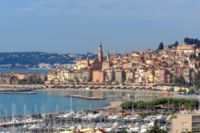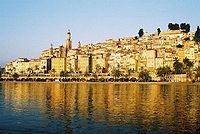- Menton
-
Menton
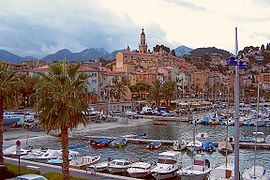
Administration Country France Region Provence-Alpes-Côte d'Azur Department Alpes-Maritimes Arrondissement Nice Intercommunality Riviera française Mayor Jean-Claude Guibal
(2008–2014)Statistics Elevation 0–774 m (0–2,539 ft)
(avg. 16 m/52 ft)Land area1 14.05 km2 (5.42 sq mi) Population2 28,833 (2008) - Density 2,052 /km2 (5,310 /sq mi) INSEE/Postal code 06083/ 06500 1 French Land Register data, which excludes lakes, ponds, glaciers > 1 km² (0.386 sq mi or 247 acres) and river estuaries. 2 Population without double counting: residents of multiple communes (e.g., students and military personnel) only counted once. Coordinates: 43°46′30″N 7°30′00″E / 43.775000°N 07.50°E
Menton (French pronunciation: [mɑ̃tɔ̃]; Occitan: [meˈta], written Menton in classical norm or Mentan in Mistralian norm; Italian: Mentone) is a commune in the Alpes-Maritimes department in the Provence-Alpes-Côte d'Azur region in southeastern France.
Situated on the French Riviera, along the Franco-Italian border, it is nicknamed la perle de la France ("The Pearl of France").[1]
Contents
History
The Menton area has been inhabited since the paleolithic, and is the site of the original "Grimaldi Man" find of early modern humans, as well as remains of Neanderthals and Cro-Magnons.[2] In Roman times, the via Julia Augusta, a road connecting Placentia (now Piacenza) with Arelates (now Arles) passed through Menton, running along the Rue Longue in the old town.[3] The first major settlement occurred during the 11th century CE, when the Count of Ventimiglia constructed the Château de Puypin (Podium Pinum) on the Pépin hill, north and west of the modern town center. During the 13th century, the seigneury of Puypin fell to the Vento family of Genoa who built a new castle along the Roman road, now the site of the Vieux-Château cemetery, providing the core around which the current town grew. Menton was thus incorporated into the Republic of Genoa. The first mention of Menton dates from 21 July 1262, in the peace treaty between Charles of Anjou and Genoa. Its position on the border between the Angevin-ruled Provence and the Republic of Genoa, which at the time claimed Monaco as its western limit, made it a coveted location.
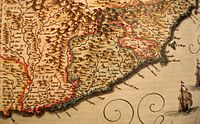 Menton -as part of Monaco- was the extreme western area of the Republic of Genoa (green color) in 1664
Menton -as part of Monaco- was the extreme western area of the Republic of Genoa (green color) in 1664
Acquired in 1346 by Charles Grimaldi, Lord of Monaco, Menton was ruled by the Princes of Monaco until the French Revolution. Annexed during the Revolution, Menton remained part of France through the First Empire. It belonged to the district of Sanremo in the department of Alpes-Maritimes, which at the time included Monaco and Sanremo.
In 1814, Menton was included in a reconstituted principality of Monaco which, after Napoleon's Hundred Days in 1815, became a protectorate of the King of Sardinia. The Princes of Monaco were obliged to do feudal homage (anachronistic at that late date) to the King for Menton, although not for Monaco itself.
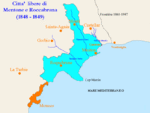 Map of the territory of the "Free cities of Menton & Roquebrune in 1848[4]
Map of the territory of the "Free cities of Menton & Roquebrune in 1848[4]
In 1848, Menton, along with its neighbour Roquebrune, seceded from Monaco, due at least in part to a tax imposed on lemon exports.[5] They proclaimed themselves a "free city" during the 1848 revolutions related to the Italian Risorgimento, then two years later placed themselves under the protection of the Kingdom of Sardinia where they were administered by the House of Savoy for ten years.[6]
The Treaty of Turin concluded on 24 March 1860 between the Kingdom of Sardinia and Napoleon III's France called for the annexation of the County of Nice to France, subject to a plebiscite, as a reward for French assistance in Italy's war against Austria. The plebiscite, with universal adult male suffrage, was held on April 15 and 16, 1860 and resulted in an overwhelming vote in favor of annexation (833 for vs 54 against in Menton and Roquebrune),[7] despite complained of rigged elections from, among others, Nice born Italian nationalist Giuseppe Garibaldi[citation needed]. The county of Nice was thus annexed to France that June, and Napoleon III paid 4 million francs in compensation to the prince of Monaco, who renounced his rights in perpetuity on 2 February 1861.[7]
From the end of the 19th century, tourism became an important factor in Menton. The town was popular with English and Russian aristocrats who built many of the luxurious hotels, villas, and palaces which still grace Menton today. Many of these hotels and palaces were pressed into service as hospitals during World War I to allow injured troops to recuperate in a pleasant climate.
Menton was the only sizable settlement captured by Italy during its invasion of France in June 1940. Following the armistice of June 22, 1940, two thirds of the territory of the commune was annexed by Italy as "terra irredenta". The annexation lasted until 8 September 1943.
Although officially returned to Vichy France, Menton was in fact occupied by Nazi Germany until its liberation by American and Canadian troops of the First Special Service Force on 8 September 1944.[8]
Geography
Menton, nicknamed the Pearl of France, is located on the Mediterranean Sea at the Franco-Italian border, just across from the Liguran town of Ventimiglia. It boasts a warm micro-climate favorable to lemon, tangerine, and orange groves whence one of the town's symbols, the lemon.
The fishing industry was devastated in the 1980s and 1990s when the "killer algae" Caulerpa taxifolia (a non-native Asian tropical green algae first discovered in the Mediterranean Sea adjacent to the Oceanographic Museum of Monaco in 1984) spread throughout the coastal sea floor, greatly reducing local fish populations.
Population
 Musée Jean Cocteau
Musée Jean Cocteau
Historical population of Menton 1962 1968 1975 1982 1990 1999 2008 19,915 25,054 25,143 25,086 29,141 28,812 28,833 Townscape
Menton is famous for its gardens, including the Jardin Serre de la Madone, the Jardin botanique exotique de Menton ("Le Val Rahmeh"), the Fontana Rosa, and the Maria Serena garden. Le Val Rahmeh was established in 1905 by Englishman Sir Percy Radcliffe, the first owner of the gardens, and named for his wife. Villa Fontana Rosa was built in 1922 by Blasco Ibáñez, a Spanish novelist, and the gardens of the villa are now open to the public.
- The baroque basilica of Saint-Michel-Archange, with its bell-tower, was built in 1619 by the Genoese architect Lorenzo Lavagna.
- The Musée Jean Cocteau is located in the Bastion of the port of Menton. The bastion, built overwater in 1636 as an advance defense for the port by the Princes of Monaco, is now located at the shoreline.
- The wedding room at the Mairie (town hall) was painted in the 1950s by Jean Cocteau, transforming it into a giant work of art.
- Menton is home to at least half a dozen beaches
- The historic covered market was built in 1898 by local architect Adrien Rey. The market is open everyday from 5am until 1pm in the summer and in winter opening at 5:30am. Over 30 kiosks both inside and around the market sell local and imported vegetables. The belle epoque structure was one of many famous buildings constructed by the architect in the region.[9]
Mentonasc language
The Mentonasc dialect is currently spoken by about 10% of the population in Menton, Roquebrune, and the surrounding villages.[citation needed] It is taught within the French educational system, as a variety of Niçard (i.e. Provençal and Occitan). However, in nineteenth century linguistic descriptions,[10] as well as in contemporary linguistic scholarship[11][12][13] Mentonasc is described as an intermediate between Niçard and the Intemelio dialect of Ligurian. Some scholars insist that Mentonasc is, at it base, a Ligurian dialect, with French influences coming only later,[14] and that its supposed misclassification as a variety of Provençal has essentially political motives.[15]
Origin of the name
"Menton" is the French word for "chin". According to the French geographer Ernest Nègre, the name Menton comes from the Roman name Mento.[16] However, it is possible that the name of the city comes from Mons Ottonis (reconstituted) from the name of Otton II, the Count of Ventimiglia from 1162-1200.[17] In Mentonasc, the city's name is Mentan (pronounced [mẽˈtã]), and in Italian Mentone ([menˈtoːne]).
An inhabitant of Menton, un mentonnais or un mentonasque in French, would be O mentonasc in the local dialect.
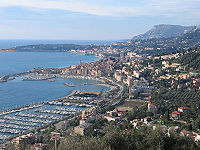 View of the port of Menton
View of the port of Menton
Annual town events
The Lemon Festival takes place every February. The festival follows a given theme each year; past themes include Viva España, Disney, Neverland, and India. The festival lasts a few days, with different bands passing through Menton's streets on foot or on truck trailers. The Casino Gardens in the centre of town are decorated in the theme of the festival, using lemons to cover the exhibits, and huge temporary statues are built and covered with citrus fruit.
The Casino Gardens are also the location for Menton's Christmas Festival.
The Menton Classical Musical Festival is also held every year in the centre of the old town.
Personalities
Notables who were born, lived, or died in Menton:
- Jérôme Alonzo (1972-), French first division football goalkeeper, born in Menton 20 November 1972.
- Richard Anconina (1953-), French actor. Before his film career, he worked for several years at a holiday club for seniors in Menton.
- Gérald Ariano (1974-), French television presenter, born in Menton.
- Ferdinand Bac (1859–1952), French illustrator, lithographer, and writer, undertook the development of the gardens of the villa des Colombières in Menton. He transformed this old run-down building into a sumptuous residence in the midst of gardens where each bed takes its inspiration from a Mediterranean country.
- Aubrey Vincent Beardsley (1872–1898), English illustrator and author.
- René Clément (1913–1996).
- Jean Cocteau (1889–1963) French artist, spent much time in Menton over the years. A memorial and museum dedicated to him are in Menton, as is the wedding room in the town hall decorated with his work.
- Olivier Echouafni (1972-), French first division football midfielder, born in Menton 13 September 1972.
- William Webb Ellis (1806–1872), the inventor of Rugby, lived in Menton at the end of his life and is buried in the old cemetery.
- Ivan Grigorovich (1853–1930), Imperial Russian Navy admiral, lived in Menton after the Russian Revolution.
- Blasco Ibanez (1867–1928), Spanish author who, at the end of his life, lived in his estate, Fontana Rosa, in Menton.
- Joseph Joffo (1931-), French author, lived temporarily in Menton during World War II.
- Anatoly Lunacharsky, a Russian Marxist revolutionary and the first Soviet People's Commissar of Enlightenment responsible for culture and education, died in Menton.
- Hernàn Ponce (1991-), French football Defender, born in Menton 16 August 1991.
- Charles H. Spurgeon (1834–1892), British Baptist Preacher, died in Menton.
- Graham Sutherland (24 August 1903 - 17 February 1980), English artist.
- Cédric Varrault (1980-), French first division football defender, began his career with the Menton football club.
- William Butler Yeats died in Menton January 28, 1939 (aged 73), writer, poet.
- Philip Meadows Taylor (1808–1876), British Indian civil servant and author
International relations
Main article: List of twin towns and sister cities in FranceMenton is twinned with:
 Baden-Baden, Germany
Baden-Baden, Germany Montreux, Switzerland
Montreux, Switzerland Namur, Belgium
Namur, Belgium Sochi, Russia
Sochi, Russia Laguna Beach, California, United States
Laguna Beach, California, United States Gisburn, Lancashire, England, United Kingdom
Gisburn, Lancashire, England, United Kingdom
See also
- Mentonasc
- Roquebrune-Cap-Martin
- List of historical unrecognized countries
- Former countries in Europe after 1815
- intermelio
- Communes of the Alpes-Maritimes department
References
- ^ "Menton, "perle de la France"" (in French). Office de Tourisme de Menton. http://www.menton.fr/article.php3?id_article=809.
- ^ Émile Rivière, Découverte d'un Squelette Humain de l'Époque Paléolithique Dans les Cavernes des Baoussé-Rousse dites Grottes de Menton (Discovery of a Human Skeleton from the Paleolithic in the Caverns of Baoussé-Rousse also known as the Grottes de Menton), (J.-B. Baillière et Fils, Paris, 1873) (in French)
- ^ La rue Longue (Official site of the town of Menton, accessed April 2009) (in French)
- ^ Ermanno Amicucci. Nizza e l'Italia. Mondadori editore. Milano, 1939.
- ^ Menton on the French Riviera (accessed April 2009)
- ^ Ermanno Amicucci. Nizza e l'Italia. p 58-61
- ^ a b Monaco, Menton, and Roquebrune
- ^ La libération de Menton (The Liberation of Menton, Official site of the town of Menton, Accessed April 2009) (in French)
- ^ http://rivierakitchen.com/project/2011/09/menton-market/
- ^ James Bruny Andrews, Il dialetto di Mentone, in quanto egli tramezzi ideologicamente tra il provenzale e il ligure (The dialect of Menton, in which it is ideologically intermediate between Provençal and Ligurian) in Archivio Glottologico Italiano XII, 1890/92, pp. 97-106. (in English)
- ^ J.-P. Dalbera, Interférences entre provençal et ligurien dans la génèse du système morphologique mentonnais (Interferences between Provençal and Ligurian in the genesis of the Mentonnais morphological system) in Bulletin du Centre de romanistique et de latinité tardive 4-5, Nice, 1989, pp. 89-97.
- ^ W. Forner L'Intemelia linguistica, in Intemelion 1, Sanremo, 1995, pp. 67-82. (in Italian)
- ^ Le mentonnais entre toutes les chaises ? in Lexique Français-Mentonnais (Caserio & al. 2001) (in French)
- ^ Werner Forner.À propos du ligurien intémélien - La côte, l'arrière-pays, Travaux du Cercle linguistique de Nice, 7-8, 1986, pp. 29-62.
- ^ F. Toso, Il brigasco e l'olivettese tra classificazione scientifica e manipolazioni politico-amministrative Intermelion #14 p. 103, 2008 (in Italian)
- ^ Ernest Nègre, General Toponym of France : Etymology of 35,000 place names, Geneva : Librairie Droz, 1990. Volume I : Pre-Celtic, Celtic, and Roman names, § 11 118, p 664 (in French).
- ^ (French)Fondation de Menton
External links
- Tourist office website
- Tourist office website (english version)
- City council website
- Menton at the Open Directory Project
- Menton travel guide from Wikitravel
Categories:- Communes of Alpes-Maritimes
- French Riviera
- Former unrecognized countries
- Former countries in Europe
- Former republics
- 1848 establishments in France
- 1861 disestablishments
- States and territories established in 1848
Wikimedia Foundation. 2010.


